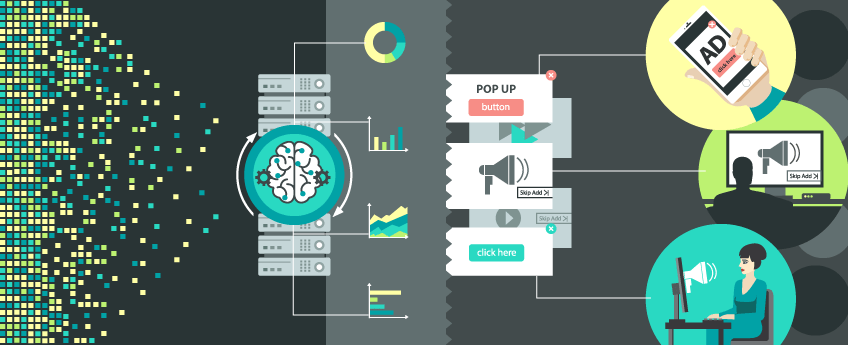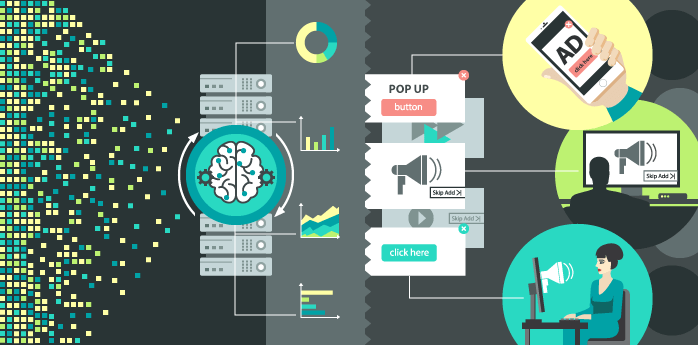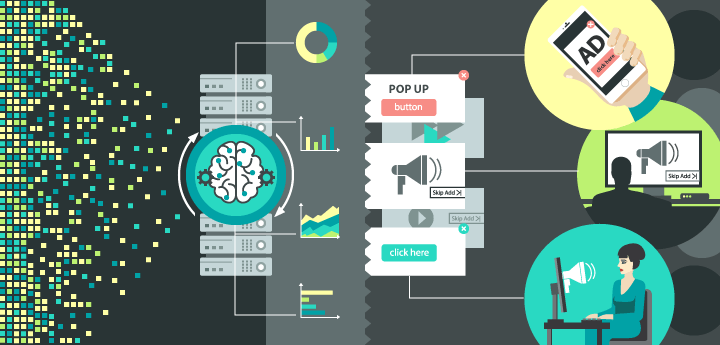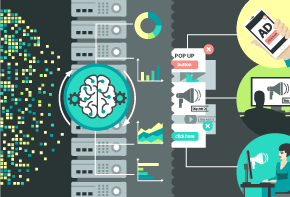Dentsu Aegis Network predicts that in 2018 digital will be the top media in terms of global advertising spend, taking over television for the first time. Digital is the future of advertising, no doubt about it, but it comes at the cost of new specific issues that traditional adtech cannot efficiently solve.
Modern consumers place higher expectations on ad quality, disrupt carefully crafted ad strategies by using several devices, and a good portion of them choose to block ads altogether. Throw in cyber security risks and unsafe content that turns away inventory buyers and robs publishers of
revenue. And that’s just the tip of the iceberg.
What Does Machine Learning Have to Offer?
In the recent years, AI technology, and machine learning in particular, have been hyped as “the savior of adtech”. An increasing number of companies use it, and even more companies put it on their wish list. So what is machine learning and what’s the big deal about machine learning-assisted advertising?
In layman terms, machine learning can be defined as the use of algorithms to seek out patterns in historical data and make automated predictions about new data. The process is continuous, enabling the machine to adapt to change and enhance itself without human interference. As such, ML is a great fit for the advertising industry with its everlasting struggle to understand and engage consumers.
Real-Time Bidding
RTB revolutionized the way advertisers and publishers interact, allowing greater flexibility for running ad campaigns and allocating ad budgets. With great flexibility, however, comes the desire to maximize its potential, to anticipate the consumer’s needs and use that to outsmart the competition. Turns out, machine learning can do that for you.
ML algorithms sift through huge volumes of consumer data to determine the probability of conversion and decide how much to bid on every single impression, all in a fraction of a second. This is the kind of meticulous work that a human could never do, and it delivers great results for DSPs who implement it.
Segmenting and Targeting
Advertisers know that for maximum impact they must address the right audience with their message. This is why much effort is being put into segmenting the motley crew of users into groups with very specific parameters like “ardent Messi supporters”, “dog owners with middle to high income”, or even “teens with low self-esteem” (way to go, Facebook).
An ML algorithm can be wired to process data about internet users and single out the parameters that would make up the perfect audience for a particular ad creative. This greatly enhances targeting, as any user’s reaction to the ad can be predicted based on their previous behavior, as well as the behavior of other individuals in the group.
Optimized Creative Decisions
Once the ML algorithm is tuned and its output verified, it can be run any number of times on new data, meaning that creative design people will be aware of shifting consumer preferences in real time. That information will be used to tweak the content or the strategy on-the-fly, providing a very high level of responsiveness.
Identification of Brand-Safe Content
Content-sharing platforms form a very lucrative advertising environment. At the same time, the vast volume of newly added content is tricky to monitor, which is why ads run the risk of appearing in an unflattering or offensive context. In this setting, a publisher’s advertising revenue is tied directly to the advertiser’s peace of mind, as YouTube discovered recently.
ML algorithms are now being trained to detect and flag inappropriate content based on human-verified examples. It’s all hands on deck at Google, whose data scientists are making computer systems analyze YouTube videos frame by frame and scour the audio commentary to identify warning signs.
Predictive Performance Analysis
Machine learning takes predictive analytics to a new level. Provided the right kind of historical performance data and insights from similar advertisers, ML-based solutions can predict how well a particular ad or campaign will engage with the chosen audience.
Such intel is invaluable before a big launch, allowing advertisers and brands to make well-informed decisions and mitigate risks.
Fraud Detection
Advertisers want their ads to be seen and clicked on by real people, but getting authentic traffic in the sea of bad bots is increasingly difficult. Anti-fraud ML solutions use streaming data to glean anomalous patterns within ad traffic and learn to tell a real person from a bot and legitimate clicks from click fraud with higher operational efficiency and scalability than traditional methods.
So, Will Machines Replace Advertisers?
The range of tasks that can be much improved with ML is staggering already, and the list of use cases is expanding. We’re already being promised automated product placement in video and voice-powered assistants that will parse natural speech into search queries to deliver highly accurate recommendations.
Theresa Agnew, CMO for GSK Consumer Healthcare, describes the advance of ML in adtech as the “move from intent-based advertising to actual one-to-one interacting.” But does this mean that the bell is about to toll for traditional ad agencies? Can machines become creative enough to advertise to humans?
Maybe not at the moment, but definitely in the future, argues this Forbes piece. The ability of machines to test a vast number of variables, assembling and reassembling them into something that evokes the desirable response, will eventually pass for creativity and make the majority of today’s ad agencies redundant.
Other sources are somewhat more optimistic about the role of humans in ML-powered adtech, at least when it comes to detection of fraud perpetrated by humans in complex areas like finance and banking.
Whichever side you find yourself on, rest assured that machine learning solutions will depend on human interference in some way for a long time to come. Meanwhile, advertisers will keep inventing new ways to reach more humans with the help of machines.
























